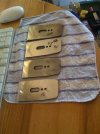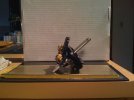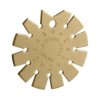Is there a standard reference most people use for setting Edge Pro angles? I've watched a ton of videos and read a lot of instructions. Most of them seem to be wrong.
The bevel of a blade edge is relative to the center of the blade, not relative to one side of it. On the EP if you measure the table angle you're measuring where one side of the blade is. If you measure the stone resting on the table you assume your blade is at the table edge. This never happens - there's always some overhang.
For a thin blade with very little overhang this is probably negligible. But it's still wrong in terms of how the angle should be measured.
I view my blade as a wedge and measure my angle relative to the center of blade. This takes an extra couple of minutes and may be more work than most people want to do. Is there an easier process I'm missing?
The bevel of a blade edge is relative to the center of the blade, not relative to one side of it. On the EP if you measure the table angle you're measuring where one side of the blade is. If you measure the stone resting on the table you assume your blade is at the table edge. This never happens - there's always some overhang.
For a thin blade with very little overhang this is probably negligible. But it's still wrong in terms of how the angle should be measured.
I view my blade as a wedge and measure my angle relative to the center of blade. This takes an extra couple of minutes and may be more work than most people want to do. Is there an easier process I'm missing?






